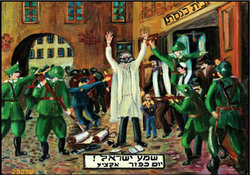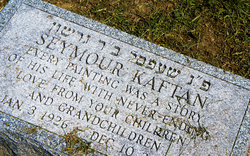Seymour Kaftan (Szepsel Kaftanski)
 Painter Seymour Kaftan (born Szepsel Kaftansk) was the son of Gershon and Sara Liba (Rudomin) Kaftanski. He was born in 1926 in Vilna, where his father was a tailor.
Painter Seymour Kaftan (born Szepsel Kaftansk) was the son of Gershon and Sara Liba (Rudomin) Kaftanski. He was born in 1926 in Vilna, where his father was a tailor.
Szepsel had a younger sister, Lea. In 1941 the Kaftanski family was forced to move into the Vilna ghetto. When the ghetto was liquidated in September 1943, Gershon was sent to the Vaivara concentration camp in Estonia, where he perished.
Szepsel went into hiding with his mother and sister in the basement of the home of Jacob Gens, a former chairman of the Judenrat. They remained there from September through November 1943, when they were discovered by the SS and their collaborators.
They were sent to Ponary, where Szepsel's mother and sister were killed.
The Ponary massacre took place between July 1941 and August 1944 near the railway station of Ponary, now a suburb of Vilnius. Some 70,000 Jews were murdered in Ponary.
Szepsel was taken to the HKP labor camp to repair trucks for the German army in an auto machine shop. When the Russian army broke through German lines in July 1944, Szepsel and several others removed their yellow stars, sneaked out of the barracks, and hid in a ditch overnight.
The next day, Szepsel left the group and hid alone in a cornfield. He came out of hiding when Russian troops liberated Vilna on July 13, 1944. After spending ten months in Vilna, he arranged to leave for Palestine with a group of former partisans. Claiming to be Greeks just liberated from the camps, they jumped a train and traveled through Czechoslovakia to Romania, Hungary, and Italy.
Most of the group was recruited by the Hagana and continued on to Palestine, but Szepsel remained in Italy. He settled in the displaced persons camp in Cremona, where he stayed until he immigrated to the U.S. in March 1948. Szepsel settled in New York.
From: Find a Grave
This exhibit tells the story of Vilnius’ Jews starting with the Nazi invasion, and including the Ponary tragedy. It does so through the visual images recorded by Seymour Kaftan—born Szepsel Kaftanjski—in 26 oil paintings.
A Holocaust survivor—he was 15 years old when the Nazis invaded his hometown—Kaftan documented his personal ordeal, depicting the horrors of Nazi brutality, the loss of his entire family, and his own survival. Kaftan, like so many other survivors, did not share his horrible experiences even with his immediate family. Then, in the 1960s, without any prompting, he began to pour out his memories on canvas.
Basically self taught in the use of oil, acrylic, copper and sheet metals, Kaftan later studied fine art at the City University of New York. He signed his work using his Yiddish name “Szepsel.” Convinced that his English was poor, Kaftan, with the help of a friend whose English he judged to be better than his own, saw to it that short texts would accompany each of the paintings, helping to illuminate his artwork.
Kaftan’s unique graphic testimony is complemented by black-and-white images of the Ponary grounds as well as texts from the Ponary Diary by Kazimierz Sakowicz. Sakowicz was a Pole who lived together with his wife in a frame cottage in Ponary’s woods, next to the murder grounds, becoming an eyewitness to the atrocities. His diary, originally written in Polish, “is a unique document, without parallel in the chronicles of the Holocaust. It stands as a bystander’s view of the activities of the Nazi extermination machine” (Yitzhak Arad in the “Preface” to the Diary) in Ponary, leaving a key testimony against the Nazi cover up that attempted to hide the crimes committed there.
From: Genocide among the flowers : Seymour Kaftan Ponary paintings


